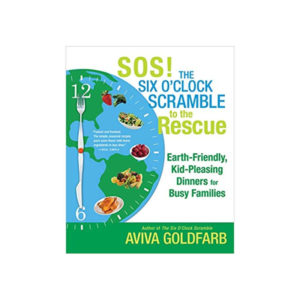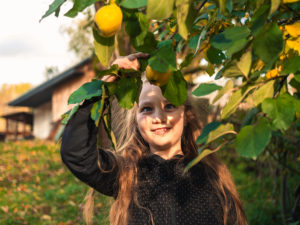
Aviva Goldfarb, author of The Six O’Clock Scramble to the Rescue: Earth-Friendly, Kid-Pleasing Dinners for Busy Families
One of the most challenging aspects to raising a healthy family has to do with executing good tasting, healthy and quick meals that your family will actually eat. One food lover and child nutrition enthusiast does just that with her well-known Six O’Clock Scramble recipe newsletter that provides healthy tips along with 5 recipes and a grocery list each week. Aviva Goldfarb, the creator of this family-friendly newsletter, who published a book also entitled “The Six O’Clock Scramble,” has a new cookbook that families may want to add to their library. It is called, “SOS! The Six O’Clock Scramble to the Rescue: Earth-Friendly, Kid-Pleasing Dinner for Busy Families.” We recently got a chance to pull Aviva out of the kitchen briefly to ask her some key questions about her new release.
Tell us a little about yourself and how you started The Scramble world.
Back in 1998 after my first child was born, I struggled to put a nutritious dinner on the table amidst the chaos of family life. As I started experimenting and devising solutions in my own kitchen, I realized I could help other parents with their family dinner challenges.
I launched “The Six O’Clock Scramble” in 2003 as a system to help busy families put easy, healthy, delicious and earth-friendly meals on the table each and every night by giving them a weekly seasonal menu and a grocery list online, which also reduces their food costs and food waste. The idea has taken off and I’m proud to have been able to help tens of thousands of people cook healthier and more earth-friendly family meals. Earlier this year I released my latest cookbook, SOS! The Six O’Clock Scramble to the Rescue: Earth-Friendly, Kid-Pleasing Dinners for Busy Families”, which helps families make food decisions and cook meals that are better for their families and for the planet.
How is SOS! different from your first book?
The new book is still full of easy and healthy family-friendly recipes, and the recipes are all new since the last cookbook, but it’s also got a new twist. I’ve realized that weekly planning and eating seasonally are actually better for the earth, in addition to being better for our families. So in this book I talk about how families can reduce their environmental impact through smart dinner-time choices, like eating seasonally, buying more organic foods, eating more meatless meals and using sustainable seafood, and eliminating food waste (according to the New York Times, a family of four will throw out an average of 24 pounds of fruits and vegetables per month, or by another estimate, 15 percent of their groceries). I even talk about how to grow some of your own herbs and veggies, and how easy it is to compost your scraps, which is also one of the best things we can do for the environment. Here are five more easy tips to reduce food waste. This book is also organized a bit more like a traditional cookbook—it’s still seasonal, which people love, but within the seasons it’s organized by meal type. Each recipe still has matching side dishes, only this time the side dish recipes are right on the same page to make it even easier for busy people to use the book.
If you had to do a “top 5” list of things that you think families could start doing today to get healthy dinners on the table faster, what would that list be?
That’s a great question! Here goes:
- Plan ahead for several meals before grocery shopping.
- Keep a grocery list in the kitchen, bring it to the store and stick to it.
- Keep side dishes simple and healthy, even fresh cut up fruit is great.
- Keep meals simple and healthy.
- Teach your family to help you with cooking and cleaning up.
- Can I add a sixth? Sharpen your knives every week or two so cooking goes more smoothly.
In my practice, I see so many families that are just trying to stop eating out and doing takeout every night. What would you say to that family that is intimidated to get cooking? How can SOS! help them be successful?
Actually, I think if people would refer to the list above it would really help them. I find that what most people do is come home from work and start thinking about what’s for dinner, which is incredibly stressful and inefficient and often leads to people heating up a frozen pizza out of frustration and hunger. But if we put in a little planning on the weekend or one night a week and plan a few meals and side dishes in advance, cooking can be a relaxing part of our nightly routines.
What do you think is the most efficient way to meal plan?
Well, besides using my service and cookbooks, where I’ve done all the work for you? I think the best way is to sit down once a week, pull out your recipes, and your calendar, and pick a recipe for each night you’ll be home. Make a grocery list that includes all the items you don’t already have and don’t forget to include a few simple side dishes (grains, vegetables and fruit), and then you can go to the grocery store once a week and get everything you need for a week of meals. That way when you come home from work you already know what you are making and you know you have all the ingredients you need, so the cooking part is simple. It’s the thinking and deciding part at 6:00 that really slows us down.
You are a queen of experimenting with new recipes and flavor combinations. Is there a method to your approach, i.e., combining certain taste sensations, or is it just random? Explain.
Well, it’s not exactly random! I have certain flavors and ingredients that I love that have a lot of flavor without adding a lot of fat and calories, like lemon and lime, garlic, chili powder, barbecue sauce, soy sauce, balsamic vinegar, scallions, etc. I sometimes jot down ideas when I travel or I eat at a friend’s house or at a restaurant, or sometimes I’m inspired by ingredients I buy at the farmer’s market, or just by conversations I have with friends (or even strangers!) about things that they have made. I just love trying new things. They don’t always come out great, but when they do it’s always a thrill.
We read a lot about getting our kids in the kitchen with us. This is a daunting task for many parents because it takes some patience. How would you suggest getting kids involved in the planning, shopping and meal preparation process?
Ever since our kids were babies we have tried to welcome them in the kitchen, especially since I spend so much time there! When they were toddlers our best ally in the kitchen was a sturdy stepladder where they could “wash dishes” in the sudsy kitchen sink while I cooked, or make their own “dinner” out of flour, food coloring, water and soap. Now Solomon and Celia are old enough to help with shopping, set the table, do the dishes, and occasionally even make meals on their own!
It does often take extra time and patience to get kids involved in meal planning and preparation, especially at first. If your time is really tight, you might consider making this a weekend tradition, at least at first, until they start to get the hang of cooking and can actually make your life easier.
I do think that letting our kids help us with meal planning, shopping, cooking and cleanup is vital so that when they are living on their own someday they will be able to provide for themselves and their own families in this way and won’t have to resort to unhealthy takeout and frozen food because they never learned how to make basic meals.
Could you make any practical suggestions for school lunches? Parents are concerned about the quality of the school lunch situation, yet making the same lunch day after day may not be the best alternative. How do we get past the PB&J?
Lunch is another area where kids can be a big help in making suggestions of what to pack and helping you pack it. We try very hard to do waste free or low waste lunches at our house, which is a challenge at first until you get the hang of it. But after a while it’s easy to wash cloth napkins and rinse out baggies—we even have some great reusable kids lunch baggies that we love, called LunchSkins . Here are Ten Easy Steps for a Trash-Free Lunch.
As far as what to pack, we always try to have a fruit, a vegetable, a grain, a protein or two, and often a small dessert, like some low fat teddy grahams, and then water for a drink. Often lunches are so full of sugar that kids get used to eating all this sweet stuff, and it can really send their energy plummeting in the afternoon during classes. Our kids really like having leftovers like soup or pasta in a thermos. I’ve found that if I put really hot water in the thermos for a few minutes first it stays warm until lunchtime. But we’re always looking for new lunch ideas so send any you have our way, too! Here is a Week’s Worth of Lunch Ideas!
Any other comments, feel free to share here!
I think it’s so important to make food an adventure that we can share and learn together with our family, rather than a source of major stress. Food is really a joy, something that can bring us together with family and friends. It’s a way to explore different cultures, and a way to connect with people all over the world. I also try to remember that since I cook at home so much and don’t spend much money in restaurants, it’s okay to splurge on wonderful ingredients that come from healthy and happy animals and local farms. Food can also be a way to support our communities and certainly a fantastic way to nourish our families. Here is one of my recent favorite recipes from my new cookbook for you to share with your readers, Angela. Thank you so much for inviting me here today to chat with you and your readers!:
Mango and Black Bean Salad
Prep + Cook = 20 minutes +
6 servings, about 1 cup each
I’ve recreated a delightful salad that our friend Tricia Nudelman enjoyed at the Genesis retreat in Ek Balam, Mexico. It’s spa-healthy yet satisfying enough for hearty eaters. Serve it with guacamole and carrots.
1 cup quick-cooking brown rice (about 2 cups prepared)
15 oz. canned black beans, drained and rinsed
1 – 1 1/2 cups fresh or frozen mango, cut in 1/2-inch chunks
1/4 sweet yellow onion, such as Vidalia, finely diced (about 1 cup)
1/4 cup scallions or chives, green parts only, finely chopped
1 lime, juice only, about 2 Tbsp.
1/4 cup fresh cilantro, chopped (optional)
1/4 tsp. salt, or more to taste
6 large Boston or butter lettuce leaves (optional)
6 whole wheat tortillas (optional)
(If using frozen mango, remove it from the freezer first.) Cook the rice according to the package directions. Remove it from the heat immediately when it is done cooking. (If you want to serve this salad immediately rather than allowing it to chill for a while, put the rice in the freezer for 5 minutes to cool it.)
Meanwhile, in a large bowl, combine the beans, mango, onions, scallions, lime juice and cilantro (optional). Combine the rice with the ingredients in the large bowl, season it with the salt, and toss it gently. Chill it for at least 10 minutes (an hour or more is ideal) and up to 24 hours. (Meanwhile, make the guacamole.)
Serve the salad on its own or wrapped in large lettuce leaves, warm tortillas, or both.
Scramble Flavor Booster: If it needs a little more flavor stir in a little honey or agave nectar, extra lime juice, and/or a little extra salt.
Tip: If you don’t like raw onions, sauté the onions first until they are lightly browned. If you have picky eaters, put some of the beans and rice aside before combining all the ingredients and let them have simple black bean and rice burritos with mango on the side.
Side Dish suggestion: To make fresh guacamole, mash the flesh of 2 – 3 avocados with about 1 Tbsp. fresh lime (or lemon) juice (1/4 – 1/2 lime or lemon). Add 1/4 tsp. salt and 1/4 tsp. garlic powder, or to taste. To jazz up your guacamole, try adding 1 Tbsp. of minced onion and/or cilantro and/or 1 tsp. minced hot peppers. Hint: To keep the guacamole from turning brown, put the avocado pit in the center of it until you are ready to serve it. Serve it with baby carrots or carrot sticks.
Nutritional Information per serving
(with 1 whole wheat tortilla) (% based upon daily values):
Calories 300, Total Fat 4.5g, 7%, Saturated Fat 1.5g, 8%, Cholesterol 0mg, 0%, Sodium 760mg, 31%, Total Carbohydrate 57g, 19% Dietary Fiber 7g, 28% Sugar 6g, Protein 9g
Visit the Six O’Clock Scramble and find out more about Aviva Goldfarb’s book and newsletter to help solve the daily question, “what’s for dinner?”
For more great books to read, check out our Recommended Reads!









